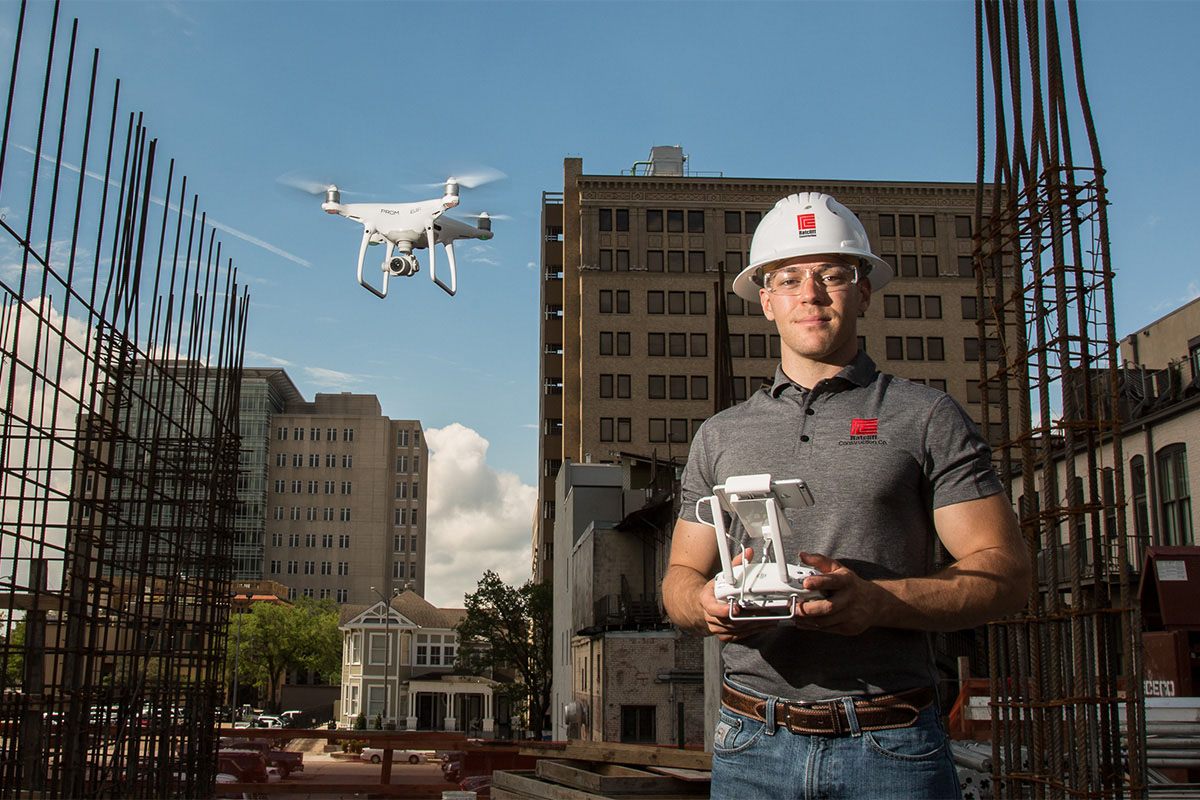Written by Columbia Southern University Alumnus John Macahan
Technology offers benefits to our lives in so many astounding ways. Various machines and devices have evolved in size and function over time to help people live, play and work.
Take the camera, for example. Once a large bulky apparatus, the camera has changed in mass, portability and purpose over the past centuries. From cell phones to medical equipment to home security, cameras can be found in almost every modern device.
One camera-wielding device that is growing in demand is the unmanned aerial vehicle, or drone. By the end of 2017, there were around 1.1 million drones in the United States, according the Federal Aviation Administration. Today, there are more than 1.5 million registered users. While the majority of today’s drones are used for recreational purposes, the FAA noted in March 2020 that 441,709 users were flying drones for commercial purposes such as agricultural applications, disaster relief, news coverage and real estate.
What is a Drone?
For those unfamiliar, drones, also known as unmanned aircraft systems (UAS), are typically small lightweight devices that feature two or more rotors or fixed wings that can hover or fly. Classified as aircraft, these little marvels feature cameras for video or photos and may use technologies such as Light Detection and Ranging (LIDAR) and thermal imaging. As an aircraft, they must be registered with the FAA and in order to fly the drone under the FAA’s Small UAS Rule (Part 107), the operator must obtain a Remote Pilot Certificate from the FAA.
Drones and the Construction Industry
According to DroneDeploy, a cloud software platform-maker for commercial drones, there has been a 239% increase in usage of drone technology. This sharp increase is due in part to the construction industry, one of the fastest growing industries to use drones. From surveying to monitoring the jobsite for Occupational Safety and Health Administration compliance, these days, drones have proven to be almost indispensable to the success of a progressive construction company. They offer an eagle eye for EHS managers and occupational safety and health professionals. In fact, DroneDeploy reported a 55% increase in safety on construction sites that use drones.
While the overall usage of drones at construction sites is very beneficial, it is the pre-construction phase that allows them to shine. It is during this time, before the project fully advances, that drones can be used to not only inspect and safeguard areas by OSH standards, but they can also help owners, construction superintendents and others successfully strategize to maximize profit and protect workers.
From an overall standpoint, the bird’s eye view of the site from the drone allows for accurate planning and decision-making based on real-time information. The drone provides aerial insights that can boost progress tracking, monitor worker pace, give heads-up about surrounding area conditions and structures, and compare real-time site conditions with pre-project map plans. Drone photography can help provide documentation that a task or project under warranty was done correctly.
What Drones Can Do Best
The most crucial thing drones can offer in construction is the opportunity to catch problems early, before they drive up costs or add to a project’s timeline. Aerial photography and video can make it very easy for a team to see existing hazards that may have been missed by either the engineer, architect or owners such as power or gas lines, property boundaries or nearby waterways.
Finding problems early is also key to meeting building and zoning codes, OSHA standards and regulations, which if not met, can lead to serious fines, delays and even shutdowns. When workers’ safety and millions of dollars are at risk, it’s much easier to be proactive than reactive. In the construction world, it is very rare when things go exactly as planned. Photographs and video from the drone can provide insight on clearances, elevations, existing buildings’ conditions, or even conflicts that workers might have to face.
For example, by comparing historical data related to a planned renovation or addition, drones can help everyone involved by determining the amount of effort and time it will likely take to match the existing structure, nearby buildings and neighborhood, etc. For an estimator or scheduler, this information is vital to assessing the amount of time and cost that needs to be allotted to that phase of the construction.
Pre-construction Offers Opportunities
The pre-construction phase is a time when safety professionals can really hone in on preparing for possible safety issues, whether they be site, equipment or worker related. For instance, there is plenty of software that allows measurements to be taken from photos with incredible accuracy. Since many of OSHA’s compliance guidelines require certain distances or measurements, drone photography and planning can ensure a company prepares to follow safe practices. This is vital for preventing fall and excavation violations.
In addition, taking aerial photos of the jobsite before construction starts can help the team with determining the safest and most efficient area to make a construction entrance or set up a muster point in the event of an emergency. From an insurance perspective, a drone can eliminate the cost of lift equipment needed to inspect a potential exterior project on an upper level. Time and date stamps on the photos also can help mitigate risk in the event litigation was ever to occur or OSHA-required documentation. As a side note, drone use to supplement the cost of certain equipment can also benefit the safety of the EHS professional by keeping that person away from the dangerous or difficult-to-reach places, especially when height is involved.
Monitoring Safety From Above
There are many ways drone videos and photography can help safety professionals monitor the progress and success of guidelines, rules or processes that were set in motion during the pre-construction phase. For example, a Stormwater Pollution Prevention Plan (SWPPP) is a site-specific document that identifies all of the activities and conditions that could cause water pollution and details what the facility will do to prevent the discharge of any unpermitted pollution. This plan reduces the risk of OSHA imposed citations by maintaining the proper and required safety plan. Through the duration of the project, a safety professional must monitor this for OSHA compliance. A quick glance at an aerial photo can make this effort easy and manageable.
Saving Money, Lives
Data gleaned from aerial photography and video allows estimators, construction superintendents, project managers and safety professionals to form strategies to help the project meet its deadline and goals. By using the data accrued during the pre-construction phase, the construction company can:
- Fine-tune estimates.
- Make allowances for real-world conditions changes.
- Reduce equipment rental and usage costs.
- Plan for more accurate worker safety measures.
- Reduce the project timeline overall.
This can help to predict and realign project estimates so that the final costs and deadline are achieved safely.
Conclusion
Drones are cost-efficient advents of technology that can help construction companies find ways to save money and ensure the safety of their workers, particularly during the pre-construction phase. All with the help of a little ol’ camera.
For more than 25 years, Columbia Southern University has been a leader in occupational safety and health education. Taught by experienced safety experts, CSU’s bachelor’s and master’s degree programs in occupational safety and health are recognized by the Board of Certified Safety Professionals as Graduate Safety Practitioner® Qualified Academic Programs. CSU’s occupational safety and health degree programs meet the educational requirements mandated by the Board of Certified Safety Professionals for the Associate Safety Professional designation (ASP®) and the Certified Safety Professional designation (CSP®). To learn more about degree programs that will help you meet the safety needs of today’s workplace, visit ColumbiaSouthern.edu/OSH or call (877) 347-6050.




